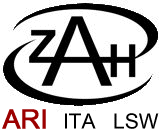Introduction to Computational Physics SS 2018 (UKWR2)
| NEWS: |
The lecture and tutorials use the elearning system (MOODLE) of the University of Heidelberg. Enrolment is requested for ALL participants of the lecture in the MOODLE system, in order to get access to the tutorial sheets and to the information exchange between lecturer and students. The enrolment for the tutorials MUST be done separately through: Physics Tutorial Management Pages (Uebungen). NOTICE: In this system it is NOT necessary to enrol to the lecture again. Only to the tutorial groups please! The names and emails of tutors will soon be listed below (not yet complete) |
| Lecturers: |
Prof. Ralf Klessen;
ZAH/ITA, Albert Ueberle-Str. 2, 69120 Heidelberg Prof. Rainer Spurzem; ZAH/ARI, Mönchhofstr. 12-14, 69120 Heidelberg |
| Time and Place: | Wednesday, 9:15 - 10:45 Uhr, INF 227 (KIP), HS 2. Friday, 11:15 - 12:00 Uhr, INF 227 (KIP), HS 2. Lecture Plan
|
| Begin/Topic: | Wednesday April 18, 2018, 09:15 (Introduction and Planning Session, Organisation of Tutorials)
Solution of physical problems with the computer. Lecture in English Language. The module UKWR2 "Introduction to Computational Physics" can be part of both Bachelor and Master studies in physics. Its description (unfortunately still only in German) can be found in the Bachelor Handbook under this link. The main pre-requirement is that we recommend to know already a high level programming language. For absolute beginners in programming it will be quite hard (though not impossible, you can try if you want) to learn programming during the lecture. Our lecture focuses, however, on programming to solve physical problems, not programming itself. Regarding physical knowledge, basic knowledge is again useful for a deeper understanding (we will work on topics from mechanics, statistical physics and quantum mechanics, for example), but the technical/numerical tasks can be solved by only following the explanations in the lecture. |
| Tutorials (English) : | Group 1 (English): Monday, 13:15 - 16:00 Uhr, Stefanie Czischek, INF 227, CIP Pool KIP 1.401 Group 2 (English): Friday, 13:15 - 16:00, Victor Ksoll, INF 227 CIP Pool KIP 1.401 Group 3 (English): Monday, 13:15 - 16:00 Uhr, Francisco Aros, Phil. 12 CIP Pool Group 4 (English): Friday, 13:15 - 16:00, Kunhe Li, Phil. 12 CIP Pool Tutors: Kunhe Li kunhe.li@stud.uni-heidelberg.de Victor Francisco Ksoll v.ksoll@stud.uni-heidelberg.de Stefanie Czischek czischek@kip.uni-heidelberg.de Francesco Aros aros@mpia.de Begin of Tutorials: Friday April 20, Monday April 23 The exercise sheets will be uploaded to the pages of our lecture in the elearning system of the university (MOODLE) every week usually until Wed evening or Thu morning by the latest. Students should summarise their answers to the exercises (graphs, values, text answers, etc) and email them to their tutors. This LaTeX template can be used to produce a PDF file containing all these items. It is just an offer - you can use any software to write and create your files as long as at the end there is one file (most preferable: pdf) with the required content. Students should also send their computer source programs to the tutor so they can be checked. One document per group is sufficient, but the names of ALL group members should be included. |
| Script: |
Manuscript of this lecture 2008/2009 . More up-to-date informations and additional reading material will be posted on our page in the E-Learning System of Univ. of Heidelberg (Moodle) (our lecture for summer term not yet opened in the system) |
| More Info: |
Here are links to supplementary informations, which will be useful and explained during the progress of the lecture.
You can see the structure of the lecture in the script and the lecture plan (see links above). The script
also contains a literature list. More informations and materials can be found in the elearning (moodle) system. Quantum States of Neutrons in gravitational field detected in Heidelberg (Press Release Univ. Heidelberg 2002, in German) Gnuplot Tutorial - plain text examples Gnuplot Tutorial - pdf Manual Gnuplot Test Data for Plotting (Filename myfile.txt) Mathematica Reference Handbook Mathematica Handbook (pdf) , or as Mathematica Notebook (by R. Kühn) For Mathematica see also some information in our lecture manuscript . |
| Supplementary Material: |
pdf file of the general introduction to computer
physics (R. Spurzem) at April 15, 2015 Runge-Kutta Methods (in German, from Schwarz, Num. Mathematik) Numerik f. Ingenieure Skript (Numerical Mathematics for En gineers, in German) more technical details on Runge-Kutta methods, see p. 77 Der Lorenz Attraktor (in German) |
(Responsible for contents: Rainer Spurzem )

